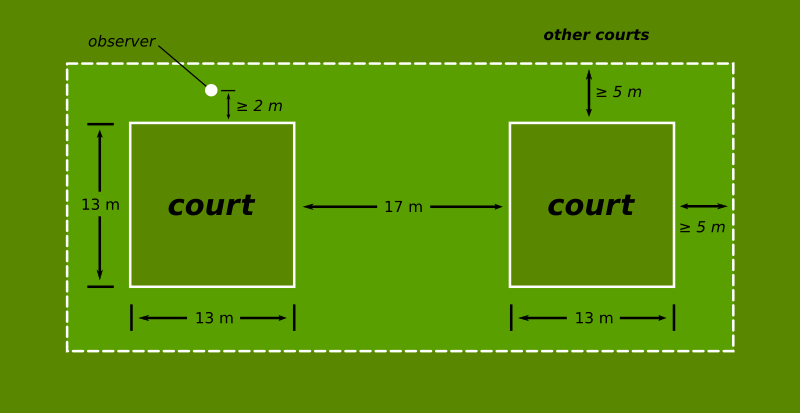Double Disc Court (DDC) is a two-person team sport that blends strategy and agility. Teams defend a court and aim to throw two discs into the opposing court, scoring points when the other team fails to catch or throws out of bounds. The game is fast-paced and requires quick reflexes and coordination.
Objective
DDC is played between two teams, each defending their own court. Two discs are in play simultaneously. Teams score points in three ways:
- When the disc lands and stays inside the opposing team’s court.
- When the opposing team touches both discs at the same time (double – worth two points).
- When the opposing team throws a disc out of bounds.
Game Setup
- Each team stands in its own court, holding one disc.
- A non-throwing player calls the start: “Ready? Two, one, THROW!”
- Both teams throw their disc simultaneously.

Gameplay
- Players must throw from where they catch the disc.
- Movement with the disc is not allowed.
- If caught outside the court, the disc is brought back in at the point where it left.
- Play continues until:
- A disc lands out of bounds.
- A disc stops in the court.
- A double is scored.
- The team that scored the last point calls the next throw-off.
- Players alternate serving each round.
Throwing & Catching
- Discs can be caught with one or two hands.
- Passing between teammates is not allowed.
- Players may tip a disc (hitting it upward before catching it) to avoid a double.
- Throws must be made from inside the court; stepping out results in a point for the opposing team.
- If both teams hold a disc and refuse to throw, the team that scored last must throw within four seconds.
Scoring
- 1 point if a disc lands and stays in the opposing court.
- 1 point against the throwing team if a disc lands out of bounds.
- 2 points if a team touches both discs at the same time (double).
- Break: No points awarded if both teams’ throws land in or out of bounds simultaneously.
- If a disc lands out-of-bounds or stops in court, any late throws do not count for points but can still result in a penalty against the throwing team.
Game Strategy
- Avoid throwing out-of-bounds – aim for the middle of the court.
- Threaten doubles – use a high, curving throw followed by a fast, straight one.
- Positioning matters – one player covers the front, the other covers the back.
- Communication is key – players must work together to escape double situations.
No Referees
DDC is self-officiated. Players are responsible for fair play. For official competition rules, contact your national flying disc association or visit the official website.

Pingback: Two Gold Medals & Fourth Overall! | Rob "Frisbee Rob" McLeod
Pingback: Rob McLeod Wins Self Caught Flight World Championship | Rob "Frisbee Rob" McLeod
Pingback: Day 3 Update: 2018 US Open – Accuracy & Double Disc Court (DDC) | Rob "Frisbee Rob" McLeod
Pingback: Physical Literacy Through Frisbee | "Frisbee Rob" McLeod
Pingback: Site Previews - 2019 World Overall Flying Disc Championships | "Frisbee Rob" McLeod